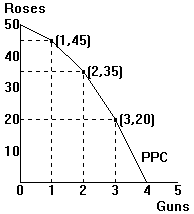| Jim Whitney |
Economics 101 |
Please do not turn this page until you are told to begin.
Quiz 1: Fall 1996
Name: ______________________________
Quiz number: ______
Greetings. Please write your name on the line above
and write your quiz number but NOT your name on the cover of your
blue book. You must turn in BOTH your test copy AND your
blue book to receive a passing grade for the quiz.
Please answer each of the quiz questions as well
as you can. Available quiz points are distributed in proportion to the
recommended time limits listed in the quiz. The recommended times sum to
45 minutes, but you will be given 55 minutes to complete the quiz. Do the
best you can on each question, and keep in mind that plenty of partial
credit is available.
Don't forget the Oxy spirit of honor. Please do NOT
discuss this quiz AT ALL until 2:30 this afternoon. Good luck!
1. (8 minutes) Answer any one of the Cooperative Learning
Lab (CLL) questions on the page attached to the end of this quiz.
(Available only at CLL.)
2. (10 minutes) This question is based on the Sullivan
case, covered in the supplementary readings selection, "A Divorced Spouse's
Professional Degree: Is It Community Property?"
a. Sketch a time path diagram which begins when
Mark and Janet Sullivan got married and extends several years beyond their
divorce ten years later. Use it to sketch (just a rough sketch is sufficient;
you don't have to include any specific dollar amounts):
(1) Mark's income stream if he had gone directly
to work with the bachelor's degree he had at the time they got married;
and
(2) Mark's educational expenses and income stream
resulting from his decision to go to medical school and become a urologist.
b. Indicate where each of the following shows up
in your diagram:
(1) Mark's earnings "during a time span comparable
to what it took to earn the degree." (Half of this amount
is what the judge in the case initially awarded Janet Sullivan.)
(2) What Mark can expect to "earn over a lifetime
with the degree [minus]...projected earnings without it." (This
is the alternative compensation formula presented in the article.)
(3) The direct educational expenditures on tuition
and books. (This is the amount allowed for compensation under
California's "Sullivan law," passed during the appeal phase of this case.)
(4) The economic (opportunity) cost for the Sullivans
of their decision to have Mark pursue his urology career.
 3. (6 minutes) Consider the production possibilities curve depicted in
the diagram to the right.
3. (6 minutes) Consider the production possibilities curve depicted in
the diagram to the right.
a. What is the opportunity cost of the third gun?
b. Make a rough sketch of the PPC in your blue book,
and use your diagram to illustrate each of the following:
(1) Temporary unemployment of some of the economy's
resources.
(2) Soil erosion which reduces productivity in the
rose industry by 50 percent.
4. (4 minutes) Use a supply and demand diagram to show
an initial equilibrium in the labor market, and use your diagram to depict
the consequences of life on Mars implied in the comic
on the front page of the quiz.
5. (9 minutes) Consider the attached article, "Taking
Flight: Low-Fat Ostrich Meat Is Going Mainstream."
a. Illustrate an initial equilibrium in the market
for ostrich meat. Then in your diagram, illustrate the consequences of
passages A and B from
the article. Make the direction of the change in both quantity and price
consistent with what the article says has been happening in the market.
b. Briefly explain the reasoning underlying any
curve(s) you shifted in part a.
c. Although the article allows us to draw firm conclusions
about how both equilibrium quantity and price have changed in this case,
can we always be certain about both when your curve(s) shift in the direction(s)
you've shown? Explain your decision.
d. Briefly explain and illustrate in a supply and
demand diagram for the meat and poultry market the potential concern underlying
passage C in the article.
6. (8 minutes) In the November election, California
voters may pass a proposition legalizing the use of marijuana for medical
purposes.
a. Depict an initial equilibrium in the marijuana
market in which the current demand is for recreational use only.
b. Illustrate in your diagram what will happen in
the market if the proposition passes.
c. Briefly explain the impact of passage of the
proposition on the quantity demanded of marijuana for recreational use,
and use your diagram to support your answer.
 3. (6 minutes) Consider the production possibilities curve depicted in
the diagram to the right.
3. (6 minutes) Consider the production possibilities curve depicted in
the diagram to the right.